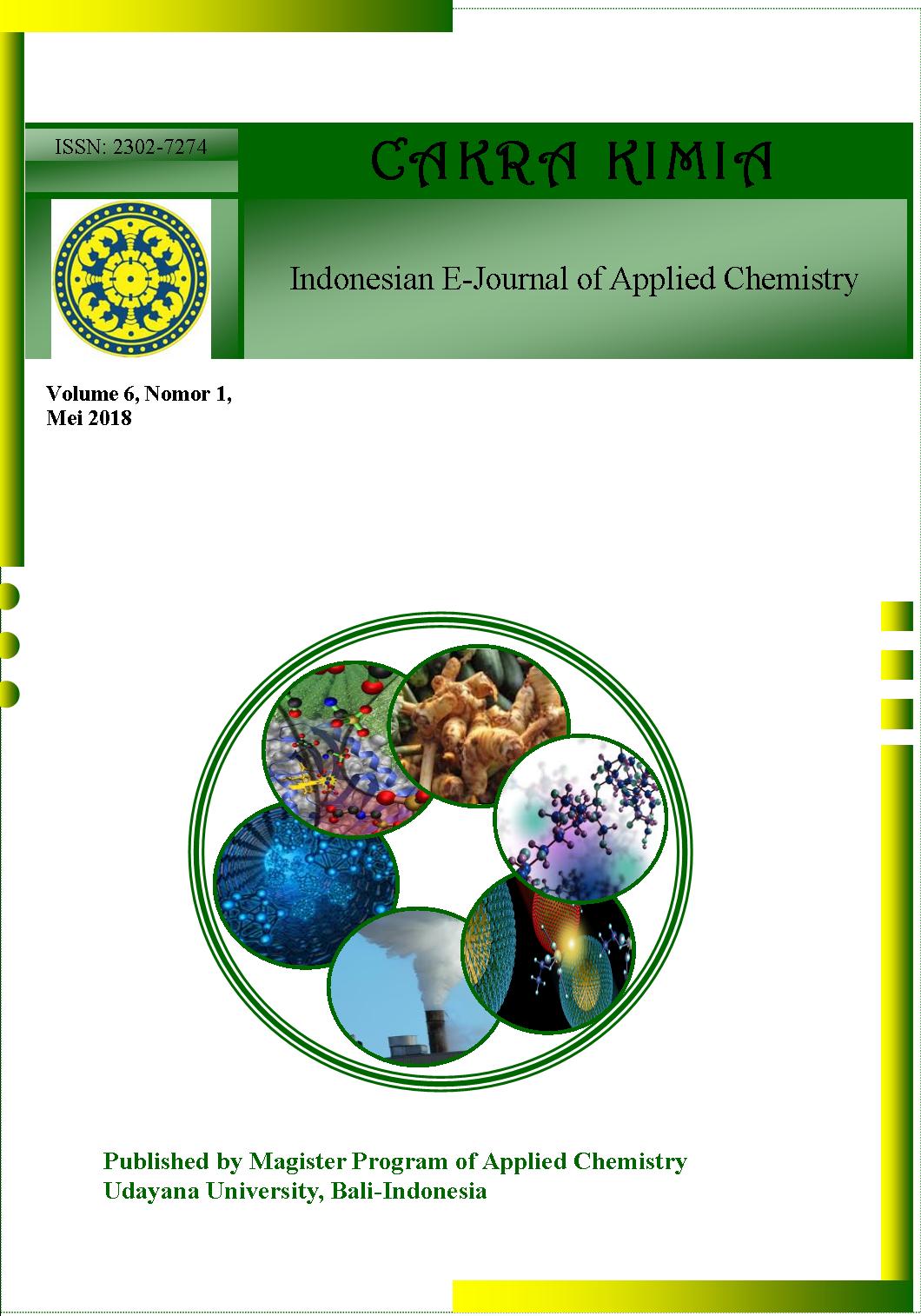POTENSI EKSTRAK LIMBAH KULIT PISANG LOKAL (Musa sp) SEBAGAI ANTIBAKTERI TERHADAP Escherichia coli dan Staphylococcus Aureus
Abstract
ABSTRAK: Penelitian ini dilakukan unuk menentukan potensi ekstrak limbah kulit pisang lokal sebagai antibakteri terhadap Escherichia coli dan Staphylococcus aureus. Penelitian yang dilakukan meliputi penentuan ekstrak limbah kulit pisang lokal (pisang mas, susu dan kayu) yang terbaik dalam menghambat pertumbuhan bakteri, penentuan pelarut terbaik, dan konsentrasi hambat minimum. Hasil penelitian menunjukkan bahwa ekstrak metanol merupakan ekstrak yang paling aktif dalam menghambat pertumbuhan bakteri dengan daya hambat sebesar 19,17 mm untuk bakteri Escherichia coli dan 18,67 mm untuk bakteri Staphylococcus aureus pada konsentrasi 10 %. Ekstrak n-butanol limbah kulit pisang mas memberikan daya hambat bakteri yang lebih baik dibandingkan ekstrak air, n-heksana, dan etil asetat yaitu sebesar 17,15 mm untuk bakteri Escherichia coli dan 16,37 mm untuk bakteri Staphylococcus aureus. Konsentrasi hambat minimum ekstrak n-butanol menunjukkan hasil hambatan pertumbuhan bakteri Escherichia coli adalah sebesar 0,5 % dengan daya hambat sebesar 7,65 mm dan 0,5% untuk bakteri Staphylococcus aureus dengan daya hambat sebesar 5,55 mm. Uji fitokimia menunjukkan bahwa senyawa yang berperan dalam aktivitasnya sebagai antibakteri yaitu alkaloid, terpenoid, flavonoid, fenol dan saponin. Kadar total fenol yang terdapat dalam ekstrak n-butanol limbah kulit pisang mas adalah sebesar 250,17 mg GAE/ 100 g dan kadar total flavonoid sebesar 129,07 mg QE/100g
Kata Kunci : Antibakteri, Escherichia coli, Staphylococcus, Musa Paradisiaca,
ABSTRACT: This research has been conducted to determine the potency of banana local peel waste (Musa sp) as antibacteria towards Escherichia coli and Staphylococcus aureus. The research included determining of the best extract of local banana peel waste (banana mas, susu, and kayu) to inhibit bacterial growth, the best solvent, and minimum inhibitory concentration. The results showed that the methanol extract has the best one to inhibit the growth of both bacteria E. coli and S. aureus with the inhibition zone of 19.17 mm and 18.67 mm respectively at concentration 10%. n-butanol extract of banana mas (Musa accuminata, AA) peel waste was the best one to inhibit both bacteria compared to water, n-hexane, and ethyl acetate extract with the inhibition zone of 17.15 mm for Escherichia coli and 16.37 mm for Staphylococcus aureus. The minimum inhibitory concentration of n-butanol extract towards both E. coli and S. aureus was 0.5% with the inhibitory zone of 7.65 mm and 5.55 mm respectively. Phytochemical screening result indicated the presence of alkaloid, terpenoid, phenols, flavonoids, and saponins which may influence the antibacterial activities. Total phenols content of the extract was 250.17 mg GAE/ 100 g while total flavonoids content was 129.07 mg QE/ 100 g.
Downloads
References
[2] Soesanto, L. dan Ruth, F. R. 2009. Pengimbasan Ketahanan Bibit Pisang Ambon Kuning Terhadap Penyakit Layu Fusarium Dengan Beberapa Jamur Antagonis. Jurnal HPT Tropika. 9 (2): 130-140.
[3] Priosoeryanto, B. P., H. Huminto., I. Wientarsih dan S. Estuningsih. 2006. Aktifitas Getah Batang Pohon Pisang Dalam Proses Persembuhan Luka Dan Efek Kosmetiknya Pada Hewan. Jurnal Biologi. 2(3): 207-213.
[4] Rastogi, P. and Mehrotra, B.N. 1999. Compendium of Indian Medicinal Plants. Drug research perspective. 2: 1-859
[5] Mokbel, M., Saif, F. and Hashinaga, F. (2005). Antibacterial and antioxidant activities of banana (Musa, AAA cv. cavendish) fruits peel. Asian Journal of Biotechnology. 3: 125-13.
[6] Ehiowemwenguan, G., Emoghene, A. O., and Inetianbor, J.E. 2014. Antibacterial and phytochemical analysis of Banana fruit peel. Journal Of Pharmacy. 4(8):18-25.
[7] Ahmad I., Beg A.Z. 2001. Antimicrobial and phytochemical studies on 45 Indian medicinal plants against multi-drug resistant human pathogens. Journal Ethnopharmacol. 74:113–123.
[8] Alisi C.S., 2008. Inhibition of dehydrogenase activity in pathogenic bacteria isolates by aqueous extracts of Musa paradisiaca (Var Sapientum). African Journal of Biotechnology. 7(12):1821-1825.
[9] Imam, M.Z. Akter S. 2011. Musa paradisiaca L. and Musa sapientum L. Phytochemical and Pharmacolo-gical Review. Journal of Applied Pharmaceutical Science. 1(5):14-20.
[10] Pelczar, M.J., dan Chan, E.C.S. 2010. Dasar-dasar Mikrobiologi. a.b Suryawidjaja, J.E. Jakarta.
[11] Arifianti, L., Oktarina, R.D., Kusumawati, I. 2014. Pengaruh Jenis Pelarut Pengekstraksi Terhadap Kadar Sinensetin Dalam Ekstrak Daun Orthosiphonstamineus Benth. E-Journal Planta Husada. 2(1): 1-4.
[12] Sabrina, G.A., Sukanto., Niken, P. 2015. Daya Antibakteri Fraksi n-butanol Kulit Buah Delima Putih (Granati fructus cortex) terhadap Streptococcus mutans. E-Journal Pustaka Kesehatan. 3:536-541.
[13] Normayunita, S., Anam, S., Khumaidi, A. 2015. Aktivitas Antibakteri Fraksi Ekstrak Kulit Buah Mentah Pisang Ambon (Musa paradisiaca var. sapientum) terhadap Staphylococcus aureus. Jurnal of Natural Science. 4(3) : 300-309.
[14] Sinarsih, N.K. 2016. Uji Efektivitas Ekstrak Daun Trembesi (Samanea saman) Sebagai Antibakteri Eschericia coli dan Staphylococcus aureus. Tesis. Denpasar: Universitas Udayana.
[15] Chang, C., Yang, M.M., We, H.C.J. 2002. Estimation of Total Flavonoid Content in Propolis by Two Complementary Colorimetric Methods. J. Food drug analisys. 10:178-182.
[16] Rita, W.S., Kawuri, R., Swantara, D. 2017. Total Phenolic and Flavonoid Contents and Antimicrobial activity of Acorus calamus L. Rhizome Ethanol Extract. Jurnal The 4th International Seminar on Chemistry 2017. ISC-2017



 Petunjuk Penulisan
Petunjuk Penulisan
